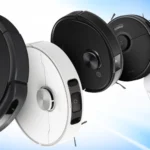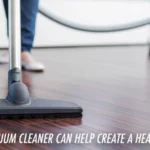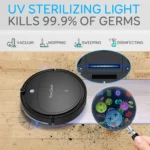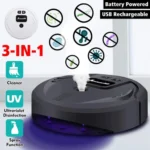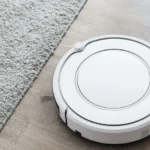As we go about our day-to-day lives, we leave behind dust, debris, and even harmful bacteria that can affect our health. This is why vacuum cleaners are an essential household tool. But with the emergence of smart technology, traditional vacuum cleaners are now competing with newer models equipped with UV sterilization. The question is, which one is better for your needs and budget? In this article, we’ll compare the features and cleaning efficiency of smart vacuum cleaners with UV sterilization and traditional vacuum cleaners. We’ll also look at the cost of each option to help you make an informed decision.
Features
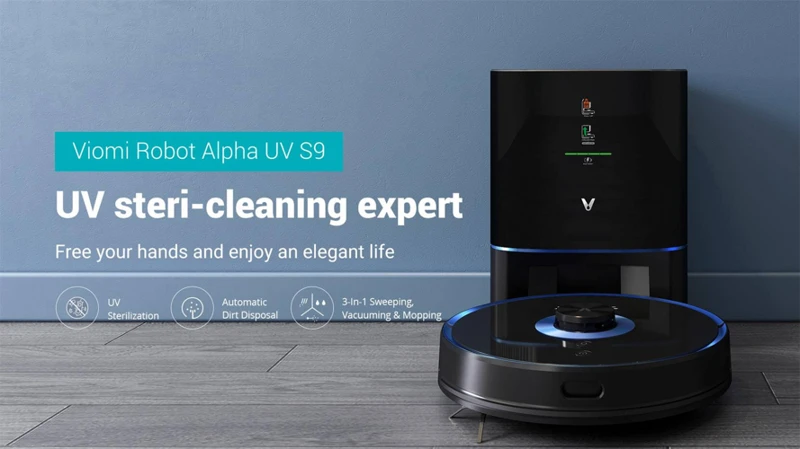
As the demand for more efficient cleaning devices continues to grow, vacuums are no exception. There are now two main types of vacuums available on the market: smart vacuum cleaners with UV sterilization and traditional vacuum cleaners. Let’s take a closer look at the features of each type to help you decide which one suits your needs best. Whether you are interested in the top factors that make a vacuum smart and efficient, or want to learn about the top smart vacuums with UV sterilization, or simply want to learn about the benefits of a smart vacuum with UV sterilization, we’ve got you covered. Keep reading to discover more about these two types of vacuums, and find out which one is the best fit for your home cleaning needs.
Smart Vacuum Cleaner with UV Sterilization Features
Smart vacuum cleaners with UV sterilization have been gaining popularity in recent times. They offer not only cleaning but also disinfecting properties for a cleaner, safer environment. Here are the top features of smart vacuum cleaners with UV sterilization:
| Feature | Description |
| UV sterilization technology | This technology uses ultraviolet light to eliminate bacteria and germs from your floors and carpets as the vacuum cleaner moves around. |
| Smart sensors | These sensors allow the vacuum cleaner to navigate your home autonomously around obstacles and furniture and clean hard-to-reach areas. |
| HEPA filter | The HEPA filter captures fine dust particles and allergens, preventing them from being scattered back into the air and causing respiratory problems. |
| Self-charging feature | When the battery runs low, the vacuum can automatically return to its charging dock to recharge itself. |
| Mobile app compatibility | The smart vacuum cleaner can be controlled using a mobile app that allows you to schedule cleaning sessions, check on the cleaning progress, and even control it remotely. |
Smart vacuum cleaners with UV sterilization are a great investment for households with pets, children, or people with allergies. The technology provides peace of mind knowing that your floors are not only clean but also germ and bacteria-free. If you want to learn more about factors to consider before purchasing a smart UV vacuum cleaner, check out our article here. Additionally, if you are interested in finding out the top smart vacuum cleaners with UV sterilization, check out our article here.
Traditional Vacuum Cleaner Features
Traditional vacuum cleaners have been around for many years and are favored by many consumers. Compared to smart vacuum cleaners with UV sterilization, traditional vacuum cleaners have some unique features that make them a popular choice. Here are some of the features of traditional vacuum cleaners:
| Features | Description |
|---|---|
| Bagged or Bagless | Traditional vacuum cleaners come with either a bagged or bagless design. Bagged designs require you to replace the bag when it’s full, while bagless designs have a canister that needs to be emptied. |
| Power | Traditional vacuum cleaners are generally more powerful than smart vacuum cleaners with UV sterilization. They have larger motors and are capable of cleaning more effectively. |
| Attachments | Traditional vacuum cleaners come with a variety of attachments such as crevice tools, upholstery tools, and dusting brushes. These attachments can help you clean hard-to-reach areas and tight spaces. |
| Manual Controls | Traditional vacuum cleaners typically require manual controls to adjust settings such as suction power and brush roll speed. |
| Noise | Traditional vacuum cleaners tend to be noisy, especially if they have a powerful motor. |
While traditional vacuum cleaners excel in some areas, they have limitations compared to smart vacuum cleaners with UV sterilization. To learn more about the benefits of smart vacuum cleaners with UV sterilization, check out our Smart Vacuum Cleaner with UV Sterilization article.
Cleaning Efficiency
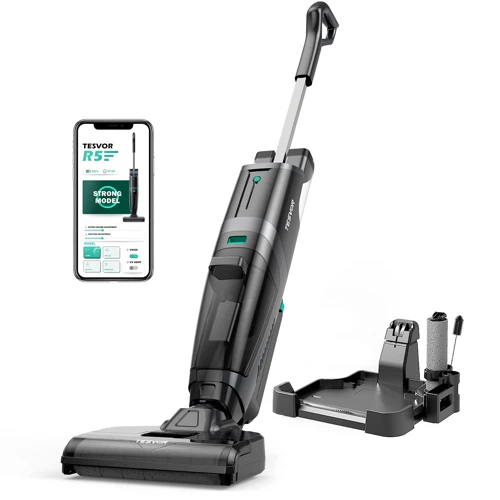
Maintaining a clean and healthy environment is crucial for our well-being. However, cleaning can often become a tedious and time-consuming task. With the advent of technology, cleaning has become more efficient, and today we’ll explore the cleaning efficiency of smart vacuum cleaner with UV sterilization and traditional vacuum cleaners. Let’s dive deeper into the benefits of both technologies and unravel how they work to ensure your living space stays free of dust, dirt, and other allergens.
How Smart Vacuum Cleaner with UV Sterilization Works?
Smart vacuum cleaners with UV sterilization work in a unique way to eliminate dust, debris, and even bacteria and viruses from your floors. This advanced technology utilizes a combination of powerful suction, high-efficiency filters, and ultraviolet (UV) light.
Here’s a breakdown of how it works:
- Suction: The vacuum cleaner sucks in air and any debris on the floor through the nozzle and into the dustbin or bag.
- Filtration: The air and debris pass through a multi-stage filtration system, which includes a pre-filter, HEPA filter, and carbon filter, to trap even the smallest particles.
- UV Sterilization: Once the debris has been filtered out, the air passes through a UV-C light chamber, which uses ultraviolet light to kill bacteria, viruses, and other microorganisms that may be lurking on your floors or in the air. UV light is an effective way to sanitize surfaces without the need for harsh chemicals or sprays.
- Disposal: Finally, the now-filtered and sterilized air is released back into the room, while the debris is stored in a dustbin or bag for easy disposal.
What’s great about this technology is that it not only cleans your floors but also helps improve the air quality in your home. Traditional vacuum cleaners may pick up surface-level dust and debris, but they don’t have the ability to eliminate harmful bacteria and viruses.
Benefits of UV Sterilization Technology
The UV sterilization technology used in smart vacuum cleaners provides numerous benefits that traditional vacuum cleaners are unable to achieve. Let’s take a closer look at some benefits of using UV sterilization technology:
- Kills Germs: UV-C technology is capable of destroying up to 99.9% of germs, bacteria, viruses, and mold spores. As the smart vacuum cleaner moves along the floor, the UV light kills germs in its path, leaving the surface disinfected and clean.
- Deodorizes: The UV sterilization technology also eliminates unpleasant odors that may arise from pet fur, dust, and other particles. The UV-C light breaks down the odor molecules, leaving your home smelling fresh and clean.
- Reduced Allergy Symptoms: UV sterilization technology with HEPA filters removes allergens like pollen, dander, and dust mites that often trigger allergies. This is especially beneficial for individuals who suffer from allergies or asthma.
- Environmentally Friendly: There is no need for chemicals or cleaning products when using UV sterilization technology, making it an environmentally friendly option.
- Easy to Use: Smart vacuum cleaners with UV sterilization are highly convenient and easy to use. With the push of a button, the device will start cleaning and sterilizing your floors.
The UV sterilization technology used in smart vacuum cleaners has numerous benefits, making them an excellent investment for individuals looking for a more efficient and convenient cleaning solution.
How Traditional Vacuum Cleaner Works?
Traditional vacuum cleaners have been used for decades, and their technology has been evolving the whole time. Here is how a traditional vacuum cleaner works:
- Suction Motor: At the base of the vacuum cleaner, there is a suction motor that creates a vacuum that sucks up dust, dirt, and debris from the floor or carpet.
- Filtration System: Once the dirt and debris are suctioned up into the vacuum, they pass through a filtration system that includes a series of filters to trap dust and allergens.
- Dustbin or Bag: The dirt and debris are then collected in a dustbin or bag that can be removed and emptied, depending on the model of the vacuum cleaner.
- Brushroll: Some traditional vacuum cleaners also have a brushroll that helps to loosen dirt and debris from the carpet fibers and pick them up more effectively.
Traditional vacuum cleaners rely solely on their suction power to clean floors and carpets. While they can be effective, they do have some limitations when it comes to deep cleaning and removing bacteria and viruses.
Limitations of Traditional Vacuum Cleaner
Traditional vacuum cleaners have been around for ages and continue to be a popular choice for households around the world. However, they do come with their own set of limitations, which can impact their cleaning efficiency. Here are some of the most prominent limitations of traditional vacuum cleaners:
- Limited Cleaning Capabilities: Traditional vacuum cleaners can only sweep up dirt and debris that are visible to the naked eye. This means that they are not effective at removing bacteria, allergens, viruses, and other microscopic particles that can be harmful to your health.
- Not Suitable for Allergies and Asthma: Dust mite feces, pet dander, and other allergens are often too small to be captured by traditional vacuum cleaners. This can be a problem for people with allergies and asthma, who need to be in a clean environment to avoid triggering their symptoms.
- Not Efficient for Deep Cleaning: Traditional vacuum cleaners are designed to pick up surface-level dirt and debris. They are not efficient at deep cleaning carpets or upholstery, which requires more powerful suction and specialized tools.
- No Disinfectant Capabilities: Traditional vacuum cleaners do not have any disinfectant capabilities or integrated UV-C sterilization technology, which can kill up to 99.9% of bacteria and viruses on surfaces.
- Heavy and Bulky: Many traditional vacuum cleaners are heavy and bulky, making them difficult to move around and store. They can also be loud and cumbersome to use, which can be a nuisance for some households.
While traditional vacuum cleaners are effective at cleaning visible dirt and debris, they do have limitations when it comes to deep cleaning, removing allergens, and disinfecting surfaces. If you’re looking for a more efficient and effective way to clean your home, a smart vacuum cleaner with UV sterilization may be the better choice.
Cost
As much as we want to prioritize the health benefits and cleaning efficiency of a vacuum cleaner, it’s also important to consider how much it costs. After all, not everyone has the same budget for home appliances. In this section, we’ll compare the cost of smart vacuum cleaners with UV sterilization against traditional vacuum cleaners. Let’s explore which type of vacuum cleaner would give you the most value for your money.
Smart Vacuum Cleaner with UV Sterilization Cost
When it comes to purchasing a smart vacuum cleaner with UV sterilization, the cost may be a concern for some buyers. The price range of these vacuums can vary depending on the features offered by different brands.
Kickstarter Vaccuum is a new brand that offers a smart vacuum cleaner with UV sterilization feature. This product is available at a relatively low price compared to other brands. The price starts at $199 for the basic model, which is equipped with basic features such as UV sterilization and obstacle detection. However, for a more advanced version, the price reaches up to $399. This version has additional features like Wi-Fi connectivity, voice control, and advanced mapping.
On the other hand, established brands like Roomba and Dyson offer smart vacuum cleaners with UV sterilization at a higher price. The price range of these brands starts from $299 for a basic model and can go up to $999 for a more advanced model. These vacuums usually have advanced features like smart mapping, automatic charging, and multiple cleaning modes.
It’s worth noting that although the cost of a smart vacuum cleaner with UV sterilization may be high, the convenience and the efficiency it provides may make it a worthy investment in the long run. Additionally, some brands may offer financing options or promotions that may make the cost more manageable for interested buyers.
To summarize the cost comparison of smart vacuum cleaners with UV sterilization, let us illustrate it in a table:
| Brand | Price Range | Features |
|---|---|---|
| Kickstarter Vacuum | $199 – $399 | UV Sterilization, Obstacle Detection, Voice Control, Wi-Fi Connectivity, Advanced Mapping |
| Roomba | $299 – $999 | UV Sterilization, Smart Mapping, Automatic Charging, Multiple Cleaning Modes |
| Dyson | $399 – $999 | UV Sterilization, Smart Mapping, Automatic Charging, Multiple Cleaning Modes |
Considering the features and the cost of the smart vacuum cleaner with UV sterilization, it’s important to evaluate your needs and budget before investing in one. By doing so, you can ensure that you purchase a vacuum that not only meets your cleaning requirements but also offers good value for your money.
Traditional Vacuum Cleaner Cost
When it comes to cost, traditional vacuum cleaners are usually the more affordable option. A basic model can cost as little as $50, while a high-end model can cost up to $500. However, the cost depends on the features of the vacuum cleaner. For example, a traditional vacuum cleaner with a HEPA filter or a bagless design will cost more than a basic model with a standard filter and a bag.
It’s important to keep in mind that the initial cost of the traditional vacuum cleaner is not the only expense to consider. Traditional vacuum cleaners require bags, belts, and filters which need to be replaced periodically. The cost of replacement parts can add up over time, especially if the vacuum cleaner is used frequently.
Additionally, traditional vacuum cleaners are not always as energy-efficient as their smart counterparts, which can lead to higher electricity bills over time. While the cost of a traditional vacuum cleaner may seem lower at first, it’s important to consider the long-term expenses as well.
While traditional vacuum cleaners may be more affordable to purchase initially, the cost of replacement parts and electricity bills over time should be taken into consideration.
- Basic models can cost around $50
- Higher-end models can cost up to $500
- Cost can vary depending on features such as HEPA filter or bagless design
- Replacement parts can add to long-term expenses
- Energy efficiency may be lower than smart vacuum cleaners
Conclusion
In conclusion, it is safe to say that the Smart Vacuum Cleaner with UV Sterilization is a game-changer in the world of cleaning technology. It offers features such as UV sterilization that traditional vacuum cleaners lack, making it a more efficient and effective cleaning option. The benefits of UV sterilization technology cannot be overstated, as it is capable of killing bacteria, viruses and other harmful microorganisms that can cause allergies, asthma and other health issues.
Traditional vacuum cleaners, on the other hand, rely solely on their suction power to remove dirt and dust, but are limited in their capability to fully sanitize surfaces. They are also often bulkier and less maneuverable than smart vacuums.
When it comes to cost, smart vacuum cleaners with UV sterilization technology are generally more expensive than traditional vacuum cleaners. However, their advanced features and cleaning efficiency make them a worthwhile investment for those who prioritize cleanliness and hygiene in their homes.
In the end, choosing between a Smart Vacuum Cleaner with UV Sterilization and a traditional vacuum cleaner ultimately comes down to personal preferences, cleaning needs, and budget. But if you’re looking for a powerful and high-tech cleaning solution that provides added protection against germs and bacteria, the Smart Vacuum Cleaner with UV Sterilization is definitely worth considering.
Frequently Asked Questions
How does a smart vacuum cleaner with UV sterilization work?
A smart vacuum cleaner with UV sterilization works by using ultraviolet (UV) light to kill bacteria and other germs on surfaces. The vacuum cleaner uses sensors to detect dirt, debris and other contaminants on the surfaces and uses suction power to remove the dirt. Once the dirt is removed, the UV light is activated to sanitize the surfaces.
What are the benefits of UV sterilization technology?
UV sterilization technology is effective in killing bacteria, viruses and other contaminants on surfaces. It can also eliminate odors and prevent the growth of molds and mildew. When integrated into a smart vacuum cleaner, it can provide a more thorough cleaning solution for homes and other environments.
How does a traditional vacuum cleaner work?
A traditional vacuum cleaner works by using suction power to remove dirt, debris and other contaminants from surfaces. The vacuum sucks up all the dirt and stores it inside a dustbin or a bag that can be emptied out when full. Traditional vacuum cleaners may also use various attachments to clean specific surfaces or hard-to-reach areas.
What are the limitations of traditional vacuum cleaners?
Traditional vacuum cleaners are limited in their ability to sanitize surfaces due to the lack of UV sterilization technology. They also require frequent filter replacements and may not be as effective in cleaning certain surfaces or materials such as upholstery and carpets.
What is the cost of a smart vacuum cleaner with UV Sterilization?
The cost of a smart vacuum cleaner with UV sterilization can vary depending on the brand and specific features. Generally, these types of vacuum cleaners can range from $150 to $500 or more.
What is the cost of a traditional vacuum cleaner?
The cost of a traditional vacuum cleaner can vary depending on the brand, type and features. Generally, a basic upright vacuum cleaner can cost around $50 to $150, while a more advanced model can cost upwards of $500 or more.
What type of surfaces can a smart vacuum cleaner with UV sterilization clean?
A smart vacuum cleaner with UV sterilization can clean a variety of surfaces including hardwood floors, carpets, upholstery, tile, and more. Some models may also come with attachments and accessories for more specialized cleaning.
What type of surfaces can a traditional vacuum cleaner clean?
A traditional vacuum cleaner can clean a variety of surfaces such as hardwood floors, carpets, and upholstery. However, some models may not be effective on certain surfaces or materials such as delicate fabrics.
What are the main features of a smart vacuum cleaner with UV sterilization?
Smart vacuum cleaners with UV sterilization typically come with features such as sensors for detecting dirt and contaminants, suction power for removing dirt and debris, and built-in UV lights for sterilizing surfaces. Some models may also offer Wi-Fi connectivity, remote control, and specialized attachments for cleaning hard-to-reach areas.
What are the main features of a traditional vacuum cleaner?
Traditional vacuum cleaners typically come with features such as suction power, various attachments for specialized cleaning, and a dustbin or bag for storing dirt and debris. Some models may also offer HEPA filters for better air filtration and hygiene.

